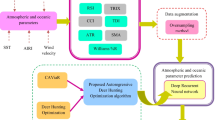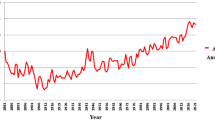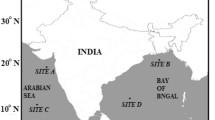Abstract
In recent years climate prediction has obtained more attention to mitigate the impact of natural disasters caused by climatic variability. Efficient and effective climate prediction helps palliate negative consequences and allows favourable conditions for managing the resources optimally through proper planning. Due to the environmental, geopolitical and economic consequences, forecasting of atmospheric and oceanic parameters still results in a challenging task. An efficient prediction technique named Sea Lion Autoregressive Deer Hunting Optimization-based Deep Recurrent Neural Network (SLArDHO-based Deep RNN) is developed in this research to predict the oceanic and atmospheric parameters. The extraction of technical indicators makes the devised method create optimal and accurate prediction outcomes by employing the deep learning framework. The classifier uses more training samples and this can be generated by augmenting the data samples using the oversampling method. The atmospheric and the oceanic parameters are considered for the prediction strategy using the Deep RNN classifier. Here, the weights of the Deep RNN classifier are optimally tuned by the SLArDHO algorithm to find the best value based on the fitness function. The devised method obtains minimum mean squared error (MSE), root mean square error (RMSE), mean absolute error (MAE) of 0.020, 0.142, and 0.029 for the All India Rainfall Index (AIRI) dataset.



















Similar content being viewed by others
Data availability
Enquiries about data availability should be directed to the authors.
References
Abuqaddom I, Basel AM, Hossam F (2021) Oriented stochastic loss descent algorithm to train very deep multi-layer neural networks without vanishing gradients. Knowledge-Based Syst 230(7553).
AIRI dataset taken from ,”https://www.tropmet.res.in/Data%20Archival-51-Page. Accessed on August 2021.
Brammya G, Praveena S, Ninu Preetha NS, Ramya R, Rajakumar BR, Binu D (2019) Deer hunting optimization algorithm: a new nature-inspired meta-heuristic paradigm. Comp J. https://doi.org/10.1093/comjnl/bxy133
Chatterjee S, Dey N, Sen S (2020) Soil moisture quantity prediction using optimized neural supported model for sustainable agricultural applications. Sustain Comp Inform Syst 28:100279
Chen S-M, Hwang J-R (2000) Temperature prediction using fuzzy time series. Syst Man Cybern b Cybern IEEE Trans 30(2):263–275
Engle RF, Manganelli S (2004) CAViaR: conditional autoregressive value at risk by regression quantiles. J Bus Econ Stat 22(4):367–381
Hähnel P, Mareček J, Monteil J, O’Donncha F (2020) Using deep learning to extend the range of air pollution monitoring and forecasting. J Comput Phys 408:109278
Handa R, Hota HS, Tandan SR (2015) Stock Market Prediction with various technical indicators using Neural Network techniques. Int J Res Appl Sci Eng Technol (IJRASET) 3(4):604–608
He Q, Zha C, Song W, Hao Z, Du Y, Liotta A, Perra C (2020) Improved particle swarm optimization for sea surface temperature prediction. Energies 13(6):1369
Inoue M, Inoue S, Nishida T (2018) Deep recurrent neural network for mobile human activity recognition with high throughput. Artif Life Robot 23(2):173–185
Lee W, Kim SH, Chu PS, Moon IJ, Soloviev AV (2019) An index to better estimate tropical cyclone intensity change in the western North Pacific. Geophys Res Lett 46(15):8960–8968
Masadeh R, Basel AM, Ahmad S (2019) Sea lion optimization algorithm. Int J Adv Comp Sci Appl (IJACSA) 10(5).
Oyewola DO, Dada EGG, Olaoluwa OE, Al-Mustapha KA (2019) Predicting Nigerian stock returns using technical analysis and machine learning. Euro J Electrical Eng Comp Sci 3(2).
Prasenan P, Suriyakala CD (2023) Novel modified convolutional neural network and FFA algorithm for fish species classification. J Combinat Optim 45(1).
Rajeyyagari S (2020) Automatic speaker diarization using deep LSTM in audio lecturing of e-Khool Platform. J Netw Commun Syst 3(4).
Salman AG, Kanigoro B, Heryadi Y (2015) Weather forecasting using deep learning techniques. In: Proceedings of 2015 international conference on advanced computer science and information systems (ICACSIS), pp. 281–285.
Sarkar PP, Janardhan P, Roy P (2020) Prediction of sea surface temperatures using deep learning neural networks. SN Appl Sci 2(8):1–14
Sea ice index dataset, “https://nsidc.org/data/G02135. Accessed on August 2021.
Shirsat P (2020) Developing deep neural network for learner performance prediction in EKhool online learning platform. Multimedia Res 3(4).
Shynkevich Y, McGinnity TM, Coleman SA, Belatreche A, Li Y (2017) Forecasting price movements using technical indicators: investigating the impact of varying input window length. Neurocomputing 264:71–88
SLH data acquired from, https://data.gov.au/dataset/ds-marlin-800eeed8-2bb3-4ba0-b5a4-ab89ab756406/distribution/dist-marlin-800eeed8-2bb3-4ba0-b5a4-ab89ab756406-0/details?q=sea%20surface%20layer%20height. Accessed on March 2021.
Soil moisture dataset, https://www.kaggle.com/amirmohammdjalili/soil-moisture-dataset. Accessed on March 2021.
Sun W, Fei Su, Wang L (2018) Improving deep neural networks with multi-layer maxout networks and a novel initialization method. Neurocomputing 278:34–40
The SST dataset will be extracted from https://www.ncei.noaa.gov/pub/data/cmb/ersst/v5/netcdf/. Accessed on March 2021.
Wang J, Li Y (2019) An innovative hybrid approach for multi-step ahead wind speed prediction. Appl Soft Comput 78:296–309
Wang Q, Tang Y, Dijkstra HA (2017) An optimization strategy for identifying parameter sensitivity in atmospheric and oceanic models. Mon Weather Rev 145(8):3293–3305
Wind speed dataset https://developer.nrel.gov/docs/wind/wind-toolkit/india-wind-download/. Accessed on March 2021.
Wolff S, O’Donncha F, Chen B (2020) Statistical and machine learning ensemble modelling to forecast sea surface temperature. J Mar Syst 208:103347
Xiao C, Chen N, Hu C, Wang K, Gong J, Chen Z (2019) Short and mid-term sea surface temperature prediction using time-series satellite data and LSTM-AdaBoost combination approach. Remote Sens Environ 233:111358
Ye X, Wu Z (2021) Seasonal prediction of arctic summer sea ice concentration from a partial least squares regression model. Atmosphere 12(2):230
Zhang Z, Pan X, Jiang T, Sui B, Liu C, Sun W (2020) Monthly and quarterly sea surface temperature prediction based on gated recurrent unit neural network. J Mar Sci Eng 8(4):249
Funding
The authors have not disclosed any funding.
Author information
Authors and Affiliations
Corresponding author
Ethics declarations
Conflict of interest
The authors have not disclosed any competing interests.
Additional information
Publisher's Note
Springer Nature remains neutral with regard to jurisdictional claims in published maps and institutional affiliations.
Rights and permissions
Springer Nature or its licensor (e.g. a society or other partner) holds exclusive rights to this article under a publishing agreement with the author(s) or other rightsholder(s); author self-archiving of the accepted manuscript version of this article is solely governed by the terms of such publishing agreement and applicable law.
About this article
Cite this article
Raj, S., Tripathi, S., Tripathi, K.C. et al. Hybrid optimized deep recurrent neural network for atmospheric and oceanic parameters prediction by feature fusion and data augmentation model. J Comb Optim 47, 66 (2024). https://doi.org/10.1007/s10878-024-01159-1
Accepted:
Published:
DOI: https://doi.org/10.1007/s10878-024-01159-1




